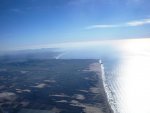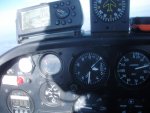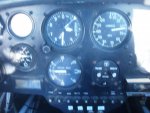- Joined
- Oct 30, 2003
- Messages
- 18,374
- Location
- Santa Maria, California
- Aircraft
- Givens Predator
- Total Flight Time
- 2600+ in rotorcraft
I had not identified the practical ceiling for the Predator with the IO-320B1A and my three blade 68inch 47” pitch Catto propeller.
The prop is a little over pitched but we are hoping it will be just right for Mariah Gale. We climbed out at 2,400 rpm.
The winds were relative calm and the altimeter setting was 30.9.
It was 59 degrees F (15 C) when we took off from San Luis Obispo with full tanks and a full stomach. I firewalled her and left it there. I leaned her every 2,000 feet of additional altitude.
I called Santa Barbara Approach and told them I wanted to find my practical ceiling over the Oceano airport and asked for flight following. They gave me a transponder code and radar contact was established 1.7 miles from SBP at 2,200 feet.
50 minutes later I had climbed to 12,500 feet. I actually climbed to 12,700 feet but that picture didn’t come out.
My 30 foot, 8.5 inch chord Sport Copter blades were turning 369 RPM.
At 12,000 feet MSL Santa Barbara Approach asked me if I had oxygen on board. I did not.
I don’t know if it was the thin air or my fear of heights but I felt light headed.
I found on the way down that at 50kts we descend at 960 feet per minute and 800 feet per minute at 40 kts indicated air speed with the engine at idle. I coasted for 12 statute miles, all the way to SMX and did a practice engine idle landing. That is a 5 to one glide ratio.
This means I can fly to Big Bear and on a cool day take off from Leadville, Colorado.
She burned 6.5 gallons.
It was more fun than I expected and I am still a little wound up.
Thank you, Vance
The prop is a little over pitched but we are hoping it will be just right for Mariah Gale. We climbed out at 2,400 rpm.
The winds were relative calm and the altimeter setting was 30.9.
It was 59 degrees F (15 C) when we took off from San Luis Obispo with full tanks and a full stomach. I firewalled her and left it there. I leaned her every 2,000 feet of additional altitude.
I called Santa Barbara Approach and told them I wanted to find my practical ceiling over the Oceano airport and asked for flight following. They gave me a transponder code and radar contact was established 1.7 miles from SBP at 2,200 feet.
50 minutes later I had climbed to 12,500 feet. I actually climbed to 12,700 feet but that picture didn’t come out.
My 30 foot, 8.5 inch chord Sport Copter blades were turning 369 RPM.
At 12,000 feet MSL Santa Barbara Approach asked me if I had oxygen on board. I did not.
I don’t know if it was the thin air or my fear of heights but I felt light headed.
I found on the way down that at 50kts we descend at 960 feet per minute and 800 feet per minute at 40 kts indicated air speed with the engine at idle. I coasted for 12 statute miles, all the way to SMX and did a practice engine idle landing. That is a 5 to one glide ratio.
This means I can fly to Big Bear and on a cool day take off from Leadville, Colorado.
She burned 6.5 gallons.
It was more fun than I expected and I am still a little wound up.
Thank you, Vance
Attachments
Last edited:








